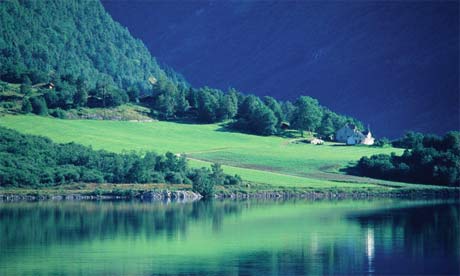
From Norway's vertiginous fjords to the tundra landscape of Swedish Lapland, or the mellow coastal scenery of northern Denmark, there is a national park out there for every type of nature lover.
Thy national park, northwest Denmark
Denmark's first national park, established last year, is a 12km-wide (7-mile) strip of land squeezed between a lowland fjord and the North Sea. It affords a tranquil panorama of sand dunes and heaths, interspersed with old fishing villages and pine forests. Cyclists can explore the region along dozens of bicycle routes, with many inns, hotels and camping sites providing special facilities – such as locked parking rooms – along the way. This is also a great spot for fishing: anglers can pick their favourite lake to catch a trout or a carp. Bird watchers will head to the nearby Vejlerne reserve, the largest bird sanctuary in northern Europe, where they can see red-throated divers, spoonbills or Brent geese.
· Fly to Aalborg or Billund, and from there take a two-hour bus ride to Thisted. More information at thy.dk.
Hardangervidda national park, south central Norway
In summer, Europe's largest mountain plateau offers a landscape of lakes and rocks lost amid mossy vegetation, with herds of wild reindeer and the odd Arctic fox passing by. Hikers cross the plateau by walking from cabin to cabin, part of a public network spread across the country and accessible to all. The western edge of the park is home to stunning snow-capped fjords, such as Eidfjord and Soerfjord, to the north the magnificent Naeroeyfjord, a Unesco World Heritage site. Hardangervidda is also stunning in winter, when it looks like it's been covered in soft whipped cream. No wonder George Lucas shot The Empire Strikes Back's snowy scenes there. Cross-country skiers replace hikers as cabin hoppers during the skiing season, which runs roughly from November to late spring.
· For northern Hardangervidda, fly to Bergen or Oslo and catch the train to Finse, Ustaoset or Geilo (up to four hours, nsb.no). For southern Hardangervidda, head to Haugesund or Oslo and take the Haukeli express bus (around four hours, nor-way.no). More information, and details of cabins at visitnorway.com and turistforeningen.no.
Abisko national park, northern Sweden
This 7,700-hectare park in Swedish Lapland comprises a low-lying valley surrounded by mountains to the west and south and a pristine lake to the north. The 435km (270-mile) King's Way trail is popular with hikers and cross-country skiers, who stay overnight in cabins along the way. Other winter activities include husky dog rides and alpine skiing - or just gazing at the northern lights spreading across the polar night. In the summer, see how little sleep you need as the midnight sun sets in.
· Fly to Kiruna and take a 1h 30min bus ride to Abisko Turist station. You can also fly to Narvik across the border in Norway. More information and details of cabins at naturvardsverket.se and visitsweden.com.
Jotunheimen national park, central Norway
Jotunheimen translates as The Home of Giants in Norwegian and is the most popular hiking area in the country. Which is no surprise since it features high ridges, glaciers, and climbs up Scandinavia's highest mountain, the 8,100ft Galdhoeppigen. Another spectacular hike runs along the Besseggen, a mountain ridge flanked by two lakes, one green, one blue, immortalised in Henrik Ibsen's play Peer Gynt. Summer activities include rafting, climbing, fishing, horse riding – even alpine skiing down the Galdhoeppigen. In winter, it's ski, ski, ski. As in Hardangervidda, visitors can hop from cabin to cabin, either unmanned ones, where you help yourself to the stocked food and leave a cash contribution when you leave; or manned ones, which are run like inns. If there's no private room available, there's always room for one more in the dormitory.
· Fly to Trondheim, Bergen or Oslo and catch a bus to Lom or Skjåk (nor-way.no, fjord1.no). More information at visitjotunheimen.com.
Ängsö national park, outside Stockholm, Sweden
Probably the most accessible national park in the whole of Scandinavia, Angso (Meadow Island) is located in the Stockholm archipelago. It is a 19th-century farm maintained according to traditional customs, dotted with quaint farmhouses and wooden fences. The best time to visit Ängsö is in spring, when the meadows of cowslips and wood anemones are in full bloom. You can take a guided tour around the island or just explore it at your own pace, but it's best to bring a picnic as there are no restaurants. There is no accommodation on the island but you can hire kayaks from a nearby island and paddle around Ängsö.
· Fly to Stockholm, then catch a two-hour boat ride from the city centre pier. More information at naturvardsverket.se and stockholmtown.com.
Getting there
British Airways (ba.com) and Scandinavian Airlines (scandinavian.net) fly from the UK to all major Scandinavian cities. Local airlines such as Norwegian (norwegian.no), Sterling (sterling.dk) and Widerøe (wideroe.no), as well as low-cost Ryanair (ryanair.com) and Jet2 (jet2.com) also connect Scandinavia to Britain. Ferry crossings to Norway, Sweden and Denmark with DFDS, Fjord Line and Direct Ferries.

